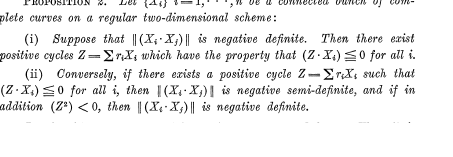My question refers to M. Artin's paper "On Isolated Rational Singularities of Surfaces"; more precisely the proof of Thm 4 on page 133. Here the relevant excerpt:
The Setting: Let $\bar{V}=Spec(A)$ where $A$ is a local, normal $2$-dimensional ring with algebraically closed residue field $k=A/\frak{m}$.
Let $\pi:V \to \bar{V}$ be a birational proper map with $V$ regular, i.e. it "resolves" the singularity $s$ of $\bar{V}$, where the point $s$ corresponds to the maximal ideal $\frak{m}$ $ \subset A$.
Denote by $Z= \sum_i X_i$ the fundamental cycle; here the definition:
$Z$ is defined as the unique smallest cycle satisfying property
One of the intermediate steps in the proof is to show that for the ideal $I_Z \mathcal{O}_V$ that determines the fundamental cycle (that is a closed subscheme of $V$) we have
$$\mathfrak{m} \cdot \mathcal{O}_{\text{V}}= I_Z$$
Artin reduces the problem to verification of the surjectivity of
(*) $$H^0(Z, \mathcal{O}_{(n+1)Z}) \to H^0(Z, \mathcal{O}_{nZ})$$
for each $n$.
Lemma 5 proves it.
Problem/Question: Then it is claimed that "moreover, because of (*), it follows that the canonical map $A/\mathfrak{m}$ $ \to H^0(nZ, \mathcal{O}_{nZ})$ is surjective.
Why? I don't understand it. How the argument works?
What I tried: My first approach was to argue by induction but this gives an obstacle that I can't solve.
Denote $K_n:= ker(\mathcal{O}_{(n+1)Z} \to \mathcal{O}_{nZ})$. One can show that $K_n \cong I_{nZ} \otimes_V \mathcal{O}_Z$ and one obtain the diagram
$$ \require{AMScd} \begin{CD} \mathfrak{m}^n/\mathfrak{m}^{n+1} = \mathfrak{m}^n \otimes A/\mathfrak{m} @>{} >> A/\mathfrak{m}^{n+1} @>{} >> A/\mathfrak{m}^n \\ @VaVV @VbVV @VcVV \\ H^0(V, K_n) @>{} >> H^0(Z, \mathcal{O}_{(n+1)Z}) @>{}>> H^0(Z, \mathcal{O}_{nZ}); \end{CD} $$
By induction hypothesis we may assume that $c$ is surjective. Question/Problem: Why is $a$ surjective? (we need surjectivity of $a$ to conclude that $b$ is surjective).
Additionally let lose some of words on inkspot's observation about the map $ H^0(nZ,O_{nZ}) \to A/{\mathfrak m}^n $: I think that it is a typo and the map should be $A/{\mathfrak m}^n\to H^0(nZ,O_{nZ})$ because considering the composition $nZ \subset V \to \bar{V}=Spec(A)$ induces naturally $A \to H^0(nZ,O_{nZ})$ which factorize through $\mathfrak m^n$, thus I think the only map which can be extracted can only go in the opposite direction of that one in Artin's paper.


